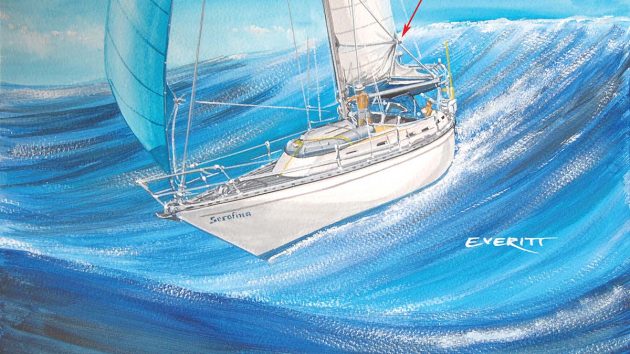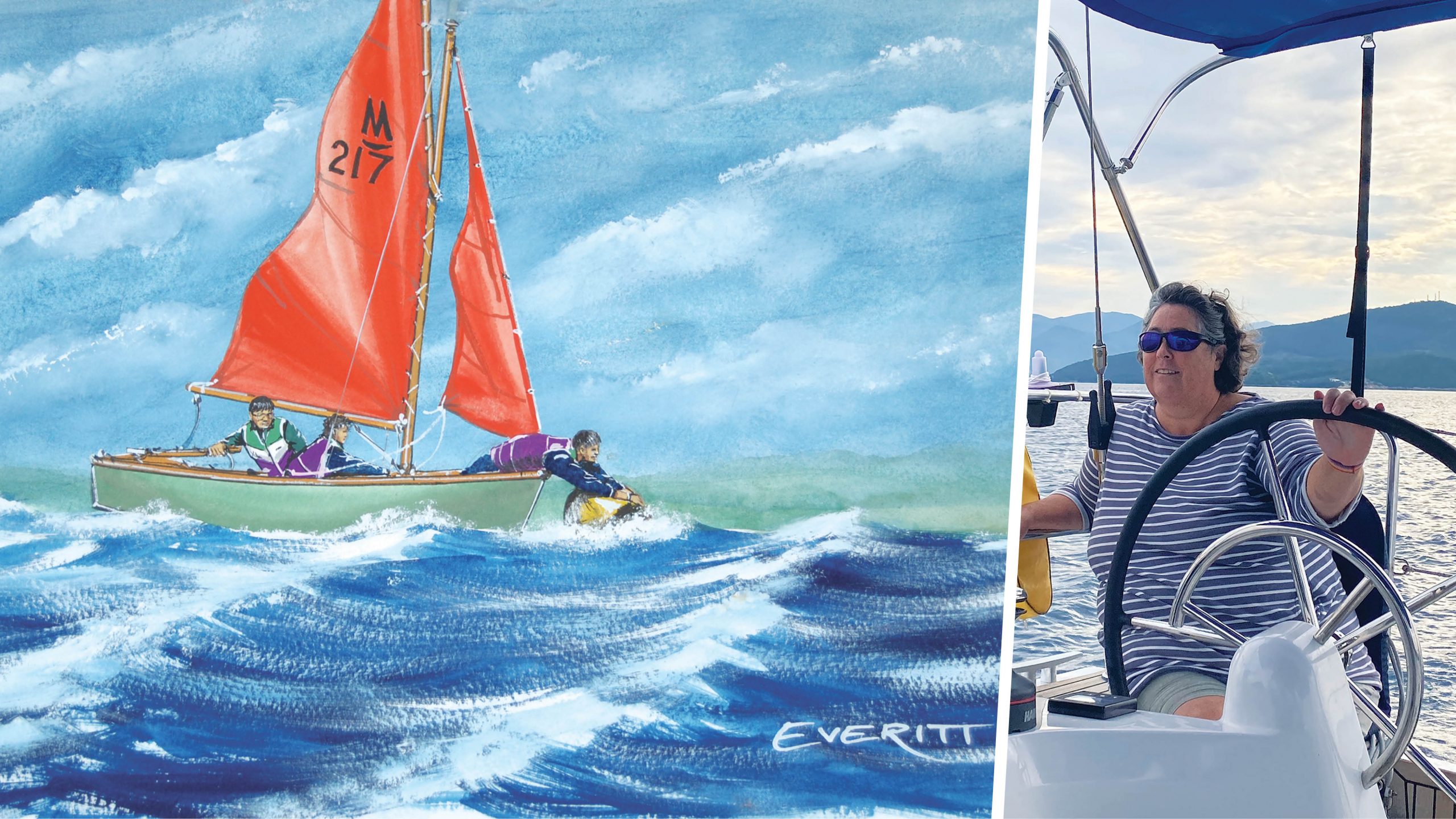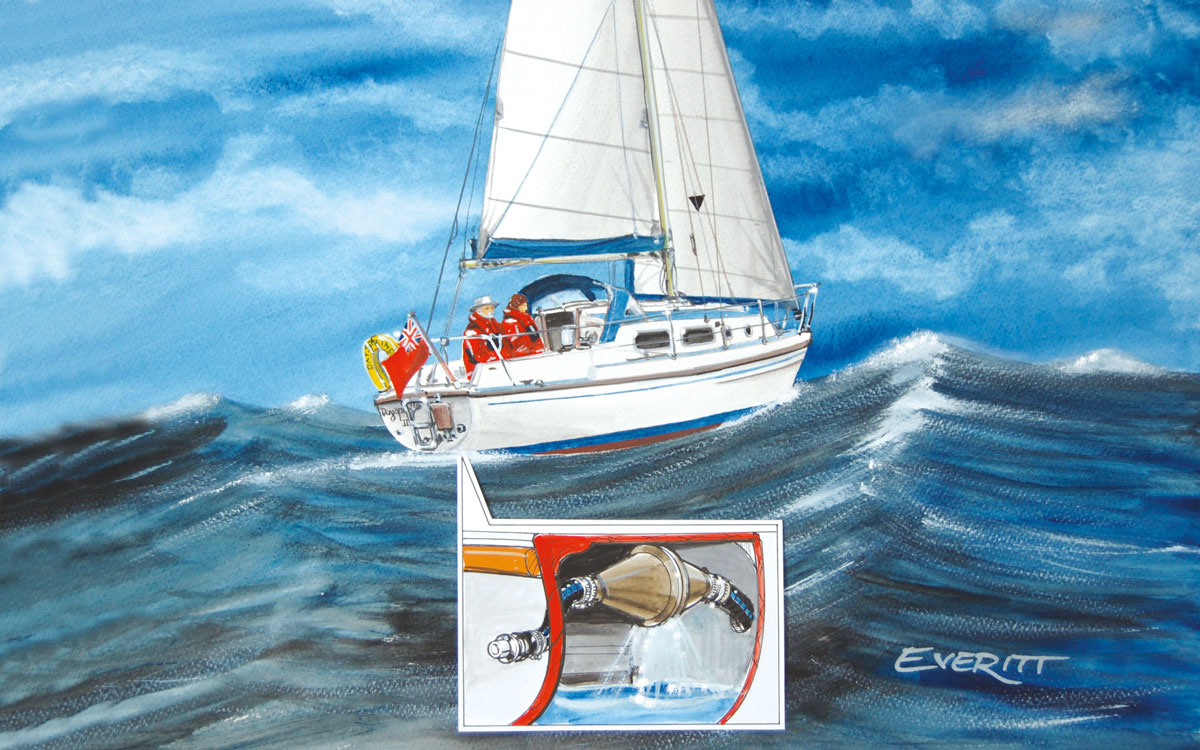Roger Geary and Liz Lawrence tackle a series of gear breakages while sailing in rough conditions from Panama to the Marquesas...
People think of the doldrums as an area of light or no wind (it can, indeed, be like this), but it is violently stormy, equally often, with wind from any direction. Moreover, it is not an evenly wide band stretching across the oceans just north of the equator as the school atlas shows.
Rather it moves north in the northern hemisphere summer and south in winter; it is also T-shaped with the head of the T oriented north and south, giving a much thicker band at the eastern side of the great oceans. We were sailing down the head of the T when things began to go wrong.
The mainsail outhaul snapped; the frayed end disappearing into the boom – a quick fix was to put a reef in; as each reef point is in effect a separate outhaul – a more permanent solution was affected, during a lull, by feeding a spare length of rigging through the boom with a mousing line attached and reattaching a line.
Article continues below…
Are we sinking? My worst day as a pregnant sailor
Fraser and I have almost sunk several times in all the years we’ve sailed together. Once was when we unknowingly…
Learning from experience: Chasing the leak on a sinking boat in Lyme Bay
Dr Brian Johnson became quickly and intimately acquainted with his engine’s silencer when it threatened to sink his Westerly Pageant…
The port genoa car snapped in two (the starboard one had broken on our previous passage to the Cayman Islands; at least this time the block did not hit me in the face). The headsail roller reefing, which had been allegedly fixed in Shelter Bay, jammed with the full sail out, not good with the wind gusting six to seven.
Risks and worries
It was too risky to keep the headsail out, so we performed the hard task of dropping it during a calmer moment. Progress would now be via our hanked-on staysail, for rough conditions, and our large, lightweight nylon ‘drifter’ during lighter winds should we encounter any!
At least this stopped another problem from worsening: the headsail stitching was beginning to unravel. Most worrying of all, we seemed to be taking on water at an alarming rate – it appeared the bilge pumps simply could not keep up.

Approaching the Marquesas with the drifter set
All the through-hull fittings appeared sound, so the anchor locker was a prime suspect as I knew the engineer at Ram Marina in Guatemala had cut a hole to accommodate the new anchor winch. During a calmer moment, I went to the forepeak to find the anchor locker full of water (the drain hole was blocked).
The hole around the new anchor winch had not been sealed! I considered diverting to Ecuador for repairs, but feared a similar lack of expertise and parts to which we had encountered in Panama.
Conditions had moderated somewhat, Liz had recovered from her seasickness and now I’d unblocked the anchor locker drain hole the bilge pumps had got the better of the leak. I decided to carry on.

Liz at the helm of the 37ft Colvic Countess Serafina
Pressing on
We had reluctantly decided not to call in at the Galapagos, and instead to make the 4,000-odd mile trip straight to the Marquesas, because Ecuador had changed its regulations and it would cost us more than £1,000 just in clearance fees, for a three week stay.
Also, we’d left Panama late and I was anxious to avoid the Caribbean hurricane season, which can affect Pacific waters north of the equator, and to arrive in French Polynesia before October when the Pacific typhoon season kicked in.
The traditional sailing route to the Marquesas from Panama is to sail south through the doldrums, close-hauled on starboard tack against the prevailing south-westerlies until you find the south-easterly trade winds and then alter course directly for the islands, passing south of the Galapagos.
This takes advantage of a south-setting current in the Gulf of Panama and guarantees a broad reach in pleasant conditions once you’ve found the trades.
A disadvantage of this route, in addition to the time spent in the doldrums, is that you could be forced close to the Columbian/Ecuador coasts until you are forced to tack your way south.
There have been reports of isolated attacks on yachts in this region (we adopted our usual anti-piracy precautions i.e. no AIS, no lights and staying out of sight of land).

Route decider
An alternative is to pass north of the Galapagos on what should be a close-to-beam reach, angling in to cross the equator about 100º west. This would entail riding the Humboldt Current.
We decided to continue south while we were making good progress, but if forced to tack (due to the proximity of land) we would take the northern route if we could comfortably make 270° or less (any more would involve us sailing back north, zigzagging through the doldrums rather than quickly getting across the head of the T).
By day five, still in heavy rain, we were forced to tack near the Columbian/Ecuador border. Joy of joy, we could make about 260° on a reasonably comfortable close reach. The northern route it was!
The Humboldt Current is a cold water current that flows north from Antarctica up the west coast of South America before tending west, passing north of the Galapagos. The advantage of sailing in it is the 1-1.5 knot boost it gives – and it’s also rich in wildlife, bound for the tropics.

Sailing in the beautiful Marquesas islands of French Polynesia
We saw humpback, false killer and pilot whales, dolphins in schools of several hundred, all within metres of the cockpit as well as numerous birds (some of which hitched a ride on the boat for several days at a time).
A less obvious advantage of the Humboldt is that the cold water enables a water-cooled fridge, like ours, to operate with very little electrical draw on the boat’s systems. However, the cold water cools the air above it so we were wearing thermals and fleeces within half a degree of the equator!
Also, the cold air mixes with the moist, warm air of the tropics producing mist and fog. Conditions were, on occasion, reminiscent of the Bristol Channel.
Ripping sound
We had soon crossed the head of the T of the doldrums and left the rain behind, sailing on a close reach in relatively comfortable conditions. There were days when it felt like hard work, making three or four sail changes – oh for roller reefing!
In lighter conditions, with the drifter up, we could some-times get away without dropping it during squalls by bearing away onto a broad reach and letting the main out as if we were on a run – to partially blanket and depower the sail.
We passed north of the Galapagos, sighting Darwin Island, before angling in to cross the equator. At 0° 30’ north, the wind backed to the south and then south-east – we’d found the trades! However, at this latitude, they were not firmly established and for two nights died away.
‘We seemed to be taking on water at an alarming rate’
Disaster struck during one of these lulls. I went to the base of the mast to shake out reefs in the main and encountered resistance when trying to winch it up to its full height. Neither Liz nor I could see what was preventing the hoist, so I carried on winching – not a good idea!
There was a ripping sound and the stack pack split (a lazy jack had caught on the end of a batten); worse still, the full length batten along the top edge of the stack pack bent at right angles and dug a corner into the main causing three separate gashes!
Fortunately, they were all below the second reef point, so, in light winds, we were forced to double reef! We didn’t have enough diesel to motor every night and the slating of sails was likely to cause excessive wear and tear – something had to be done to increase our sail area.
We re-hoisted the genoa (the top swivel appeared to be working fine – whatever was preventing reefing was at the top of the mast) so we could pole it out to windward, thus, goosewinging with the drifter on the moveable forestay to leeward and two reefs in the main.
Our unusual sail plan seemed to work. Better still, once hoisted, the genoa magically proved capable of being roller reefed!
Tearing along
One evening, I was about to go below for a snooze when I noticed the sign of high wind clouds. We dropped and bagged the drifter, rolled up the genoa and hoisted the staysail. Feeling silly in the prevailing conditions, we sailed sedately on at three to four knots.
By midnight we were tearing along at eight knots, wishing we’d put a third reef in the main as well! This is how it stayed for the next four days – enabling some great daily runs (we averaged 140 miles per day over the entire trip).
By the time this patch of bad weather had passed we’d crossed the doldrums and equator, gained some southern latitude and the south-east trades had become well established.
We managed to remove the damaged stack pack and Liz did a great repair job at sea. On we sailed. With the roller reefing working again and the trades well established, life became easier and more comfortable and 35 days out from Panama with 4,400 miles sailed we entered the harbour at Atuona on Hiva Oa, our first stop in the Marquesas.

Landfall at Hiva Oa
The Marquesas are high, formerly-volcanic islands, sparsely populated with few facilities or infrastructure and lacking a surrounding reef. Atuona is not a comfortable anchorage – the swell works its way into the narrow harbour making the deployment of a kedge anchor essential for comfort.
Once anchored, we were visited by a neighbouring French yachtsman who congratulated us on our crossing and gave us fresh fruit. We later received similar visits from another French boat and a single-handed English sailor who’d been in the harbour for three years trying to get his engine fixed!
This mountainous, verdant island with its friendly people and laid back attitude seemed a very welcome change indeed. We walked the three kilometres from the harbour to the pretty village and cleared in with a polite, efficient gendarme in less than 20 minutes.

The village boasts a few shops, a post office and a hardware store (with some boat bits – including an automatic fire extinguisher). There is also a Gauguin Museum (he’s buried in the cemetery) consisting of the house he lived in and reproductions of his paintings.
We were pleasantly surprised when the tiny store we were provisioning in offered a complimentary car ride back to the harbour. Keen to sample some French cuisine we accepted a lift only as far as a nearby restaurant where we enjoyed chicken, cooked in batter with lemon sauce and chips!
Our time (or rather Liz’s time) in Atuona was also spent conducting sail repairs. We bagged the main, rowed it ashore and carried it a few hundred metres to an old semaphore station, high on a headland. Here there were benches and seats for spreading the sail out, a roof, a cool breeze and a stunning view.

Walk to the waterfall near Baie de Hakatea, Nuku Hiva
Liz spent three full days on the hard work of hand sewing the sail while I provided moral support and slept in the shade. After a week, we set sail for the nearby island of Tahuata.
However, the breaker switch on our anchor winch kept flicking off making it difficult and time consuming to raise the anchor.
Nevertheless, we found a delightful bay to anchor and snorkel in on Tahuata with an edging reef, beach and coconut trees.
Final challenge
We decided to visit Fatu Hiva (made famous by Thor Heyerdahl), a day sail away. However, when we tried to get the anchor up, the breaker kept tripping off.
As we had plenty of volts it appeared that the winch motor was probably damaged by the submersion it had suffered when the anchor locker had flooded. The anchorages at Fatu Hiva are extremely deep, necessitating copious amounts of chain.
Fearing that the anchor winch could fail at any moment, we changed plan and course and headed downwind for Nuku Hiva, the administrative centre of the Marquesas, where I hoped to find spare parts and technical help. This took about 20 hours; so our arrival was late at night.
We hove to offshore and entered the bay at daybreak. Nuku Hiva possesses majestic scenery, but little else. My hopes of spare parts and technical help swiftly evaporated!
Feeling rather like a beached whale I resigned myself to staying here at anchor (which I have no reliable way of raising) for the next four to five months (typhoon season) while Liz returned to the UK to see family and organise a replacement anchor winch.

Serafina is a sloop-rigged Colvic Countess 37
Lessons learned
- Don’t underestimate the doldrums – they are quite capable of providing a very unpleasant sailing experience with squalls and an uncomfortable sea state. Obviously, it is best to transit at the narrowest point. This was where our Furuno weatherfax came into its own, providing real time charting of the changing situation.
- Never carry on winching when resistance is met; it’s far better to pause and look for the source of the problem. It was my desire to quickly reef together with a heavy-handed use of the winch which caused a major tear in the mainsail.
- Always have a back-up sail plan that will enable you to keep sailing in the event of a roller reefing malfunction and/or a sail rip. Fortunately, we were well equipped with a sail wardrobe which included stay sail and drifter (we also had storm jib, trysail and cruising chute). Liz always claims that the boat has more money spent on her than she does (true) and has a more extensive wardrobe (the jury is out on this one!)
- Never rely on others, no matter how professional or well recommended, to carry out repairs or installations without thoroughly checking that their work has not compromised other aspects of the boat. I obviously checked that our new anchor winch functioned well, but it did not occur to me to also check that the engineer had not compromised the watertight integrity of the anchor locker.

Expert response
Sandy Duker, secretary of the Cruising Association blue water section, said: “Congratulations are in order for sailing a 37ft yacht 4,400 miles before reaching a landfall, and for Roger and Liz’s fortitude in dealing with all the problems thrown at them.
“Self-reliance is vital when sailing these types of distances, as is working well as a team when only two-handed. I expect Roger cursed that he had not changed both genoa blocks after the first broke, because if one side goes it is likely the other will soon; it can always be kept as a spare.
“The various sail plans used, when the roller failed (salt build-up in the bearings, perhaps washed out by heavy rain) and the mainsail was damaged, saved the use of their precious diesel. Liz’s hand-sewn sail and stack pack repairs reinforce the teamwork ethos.
“Perhaps the anchoring problem could have been overcome by using a snatch block, positioned for a reasonable lead with the rope from a chain hook passing back to a cockpit winch? In sunny climes, UV light can damage gear and rigging, therefore more attention is needed during maintenance checks.”
Got a boating experience story? E-mail pbo@futurenet.com and if it’s published you’ll receive the original Dick Everitt-signed watercolour which is printed with the article.
Why not subscribe today?
This feature appeared in the January 2024 edition of Practical Boat Owner. For more articles like this, including DIY, money-saving advice, great boat projects, expert tips and ways to improve your boat’s performance, take out a magazine subscription to Britain’s best-selling boating magazine.
Subscribe, or make a gift for someone else, and you’ll always save at least 30% compared to newsstand prices.
See the latest PBO subscription deals on magazinesdirect.com






